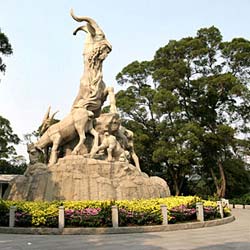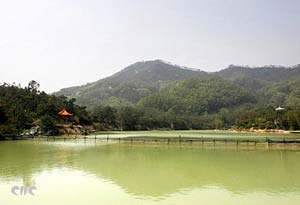
Traveling around China, I often feel as though I am in more than one country. Any Chinese person would agree that fewer two places could be farther removed than the commercial cosmopolis of Shanghai and the cultural treasure trove of Lijiang. I had that feeling on a recent visit to the nouveau riche province of Guangdong, where the dialect and cuisine are radically different from those spoken and eaten in Beijing, and where there is even a slight difference in facial physiognomy. But this disorientation evaporated upon my first of many purchases in the sultry south with RMB.
Guangdong Province is a shopper's paradise, and operates tours geared to this preferred pursuit of millions. Rather than going to sites of historical or cultural interest, they offer a chance to see new China as it will be in 20 years from now --rich, replete and satisfied. The three main must-see cities on such tours are Guangzhou, Shenzhen and Zhuhai.
Five-Ram City
Guangzhou is also known as Ram City, an epithet celebrated by the Five-Ram monument that stands on Yuexiu Hill. It honors the legend that, long, long ago, five gods riding five rams, each with a rice seedling in its mouth, descended from heaven. This reassured ancient residents of what is now Guangzhou that they and their descendants would never know famine, and contemporary Guangzhou's ongoing prosperity has proven this prophecy.
Guangzhou has something to amuse every newly minted Chinese millionaire: luxury hotels, golf courses, water parks and much more. I now feel thoroughly conversant with the leisure pursuits that attach to wealth with Chinese characteristics. The White Tiger Restaurant in the Chym Long Safari complex serves excellent food, but is most impressive for its tables being arranged so as to give a view of a whole family of white tigers that, in turn, peer back disinterestedly at the diners that surround them.
Another impressive spot is Guangzhou's night zoo, the world's second largest. At dusk visitors may board an open bus that gives a clear view of seemingly wide-awake animals. I saw pandas, lions and tigers, and also antelopes and giraffes that came close enough to touch. There is no barrier between visitors, lions and leopards other than a narrow, shallow moat. I did wonder why animals attempt neither to escape nor attack curious tourists, and was unable to obtain a satisfactory explanation. Anyway, I'm alive and well, and there have been no reports of cheetahs or tigers on the loose. I can only conclude that the zoo organizers have a divine link with St Francis of Assisi.
Shenzhen's Miniature Wonders of China and the World
At just 25 years old, Shenzhen is one of the youngest cities in China and a showcase for the reform and opening-up policy. The city's wealth has made its inhabitants, whose average monthly salary is US$450, objects of envy to the rest of China. Shenzhen was the country's first Special Economic Zone, and is the site of 20,000 enterprises and factories invested by 65 countries. Its main investor, employer and trade partner, however, is the Special Administrative Region of Hong Kong.
Among Shenzhen's forest of high-rises is the Shenzhen Empire Building, constructed in 1994. At a height of 389 m it is the third tallest in Asia.
Shenzhen's critics say that it is a cultural desert with a dearth of amusements, other than shopping. I disagree. It may lack historical monuments but there is ample entertainment for those that seek it.
Shenzhen has four big theme parks: Splendid China -- an exhibition of China's most famous sights and landmarks in miniature; Window on the World -- a similarly designed show displaying the world's scenic wonders; Folklore Villages -- model habitats of China's 55 ethnic minorities that give insight into their culture and traditions; and Happy Kingdom -- the Chinese equivalent of Disneyland, whose gigantic roller-coaster that loops two loops and has an impressively dizzying spin I found particularly thrilling, and strongly recommend.
Romantic Zhuhai

My third stop was Zhuhai, which stands on both the South-China seashore and the banks of the Pearl River. This young garden city attracts 11 million tourists a year, and acts as a gateway to Macao, in the same way as Shenzhen does to Hong Kong. It is also a Special Economic Zone in which 2,000 joint ventures operate. Zhuhai has a subtropical climate, but its plentiful beaches are not for swimmers because the water's sand content gives it a yellow-brownish color. The 100 islets off the city shores, however, have white sands, palm trees and clear blue water, and merit Zhuhai's claim to be the City of Romance. Zhuhai's main 13 km-long thoroughfare, Lovers Avenue, runs through the whole city. It is named in honor of a legend about a fisher girl, a statue of whom, holding a pearl aloft, stands in scenic Xianglu Bay, and is Zhuhai's main landmark.
The legend tells of the daughter of the dragon king, who was so enchanted by Zhuhai's beauty that she decided to come down from heaven and live there, disguised as a fisherman's daughter. She soon fell in love with a local swain named Hai Peng and they decided to marry. But certain villagers suspected that she was no ordinary fisher girl. Hai Peng's response to these rumors was to command his bride to take off the bracelet that she constantly wore. Upon doing so, the girl died instantly, as the bracelet had been her talisman and protector. Hai Peng was inconsolable at her death. An immortal named the Jiuzhou Elder was so moved by his grief that he promised to create an elixir capable of bringing the girl back to life. One of its ingredients was a herb that needed fresh blood to grow. Hai Peng unhesitatingly nurtured the herb with his own blood, and when the elixir was made, his sweetheart drank it and came back to life. The pair then married and lived happily ever after. I actually heard at least three versions of this story, but this was the only one with a happy ending, and Zhuhai is not the setting for a tragedy.
Among its pleasurable pursuits is a range of spas, all built around Zhuhai's natural hot springs. They comprise small pools of natural hot mineral waters to which herbs are added every three hours. Their therapeutic qualities are believed to be of benefit to the circulation, to relieve muscular pain and to aid digestion. Most well known is the Imperial Hot Spring, reputed to have been the resort of emperors and their concubines. Various kinds of massages, including one that involves being encased in mud, are also available.
I ended my tour of the Pearl River Delta with a sea cruise around Macao. The weather was not the best, but did not prevent my tour group from enjoying the all-time favorite Chinese pastime of karaoke, an appropriate ending to an interesting and enlightening journey.
Tips for Tourists
Spring and autumn are the best seasons to visit Guangzhou. Visitors are recommended to visit Baiyun (White Cloud) Mountain, the Chen Ancestral Temple and to take the evening cruise down the Pearl River.
-- Baiyun Mountain Scenic Area:
This scenic resort is 15 kilometers north of Guangzhou City.
Entry ticket: 5 yuan;
Tel: 020-87706871.
-- The Chen Ancestral Temple:
The temple was built at the end of the 19th century with funds raised by the entire Chen clan of Guangdong Province. The temple also served as a rest house for Chen family members that came to Guangzhou to take the province-level imperial examinations.
Entry ticket: 10 yuan;
Opening hours: 8:30 AM to 5:30 PM.
Evening Cruise down the Pearl River:
The ship sails from Dashatou Dock on Yanjiang Road.
Tel: 020-87609937.
-- Shenzhen's Window on the World
This park displaying the world's wonders in miniature is in the Overseas Chinese City in Nanshan District, Shenzhen.
Entry ticket: 120 yuan;
Opening hours: 9 AM to 10 PM.
(China Today May 9, 2006)
|

